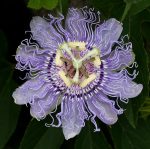 Also known as maypop, wild apricot, and wild passion vine this perennial deciduous flowering vine is native to Southeastern US where it grows near riverbanks and in thickets and disturbed areas such as pastures, meadows, roadsides, and railroads. It is a member of the Passifloraceae, a family of 750 species of mostly tropical trees, shrubs and vines, and is woody in warm climates but dies back in cold. The vines grow quickly to 6-8′ tall and sprawl on the ground or climb by axillary tendrils. They have smooth or softly-hairy stems and dark green, palmately lobed leaves that are 3-6″ long and have 3, sometimes 5, lobes, and a pair of glands at the base of the leaf stalk. The fragrant, showy flowers are 1-3″ across and have 10 white petals and sepals surrounding a crown of pinkish-purple filaments. The flowers appear from late spring to mid summer and give way to a fleshy berry known as a maypop that is 1-3″ long, egg-shaped, and pops when crushed. It is green at first but ripens to yellow in mid summer to fall and is edible to both wildlife and humans. Photo Credit: Oliver P. Quillia Wikipedia
Also known as maypop, wild apricot, and wild passion vine this perennial deciduous flowering vine is native to Southeastern US where it grows near riverbanks and in thickets and disturbed areas such as pastures, meadows, roadsides, and railroads. It is a member of the Passifloraceae, a family of 750 species of mostly tropical trees, shrubs and vines, and is woody in warm climates but dies back in cold. The vines grow quickly to 6-8′ tall and sprawl on the ground or climb by axillary tendrils. They have smooth or softly-hairy stems and dark green, palmately lobed leaves that are 3-6″ long and have 3, sometimes 5, lobes, and a pair of glands at the base of the leaf stalk. The fragrant, showy flowers are 1-3″ across and have 10 white petals and sepals surrounding a crown of pinkish-purple filaments. The flowers appear from late spring to mid summer and give way to a fleshy berry known as a maypop that is 1-3″ long, egg-shaped, and pops when crushed. It is green at first but ripens to yellow in mid summer to fall and is edible to both wildlife and humans. Photo Credit: Oliver P. Quillia Wikipedia
In the 16th century the Jesuits landed in South America and found the natives there cultivating the passionflower, Passiflora caerulea, and eating its fleshy fruits. They named the plant Flor de las cinco llagas, Flower of the Five Wounds, and thought that its floral organs symbolized The Passion of Christ. The 10 petals represent 10 apostles, rather than the more usual 12 because Peter denied his Lord and Judas betrayed Him. The corona symbolizes the crown of thorns, the 5 stamens the 5 wounds, the ovary the hammer, and the 3 styles the 3 nails. Although the species of passionflower found by the Jesuits was P. caeruleae rather than P. incarnata, the latter has similar floral parts, and is hardier and native to the US so is particular suitable for a Mary Garden.
Indigenous people used the plant as a staple food and medicinally. The edible fruit and showy fragrant flowers make passionflower a good choice for a children’s garden as well as for native plant, wildlife, butterfly, container, and medicinal herb gardens. Useful as a ground cover, the vine also looks attractive on arbors, trellises, walls and fences and grows without harming them because it climbs with tendrils.
Passionflower likes full sun and fertile, evenly moist, cool soil in USDA Hardiness Zones 6-10, but tolerates some drought and shade. Plants should be pruned in late winter to early spring if needed and mulched in the summer to keep the roots cool. Propagation is by seed and root cuttings. Plants are generally healthy but roots may rot in overly wet soil.
The genus name, Passiflora, comes from the Latin words passio meaning suffering, and flos meaning flower and refers to the suffering of Christ because the flower is symbolically associated with the crucifixion. The specific epithet, incarnata, is the Latin word meaning flesh-colored.